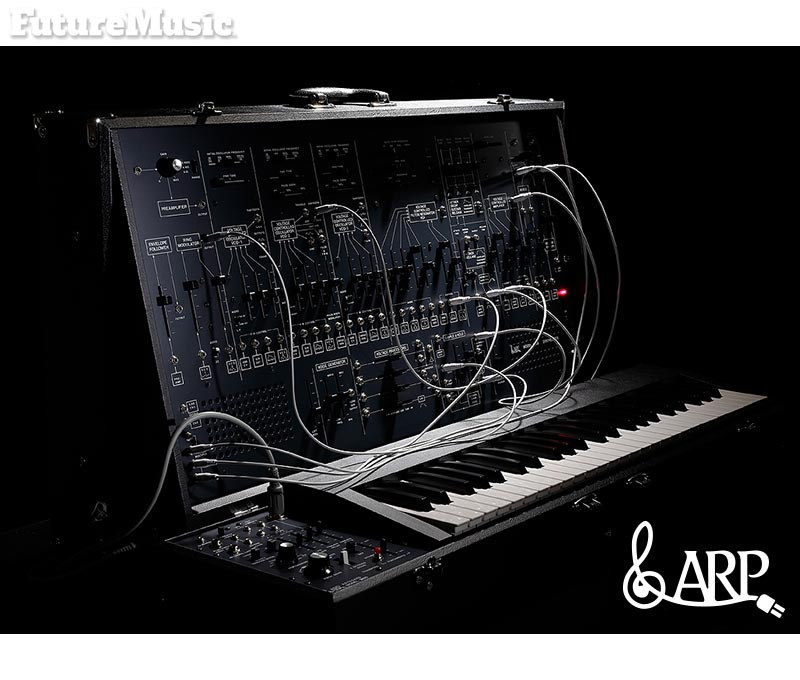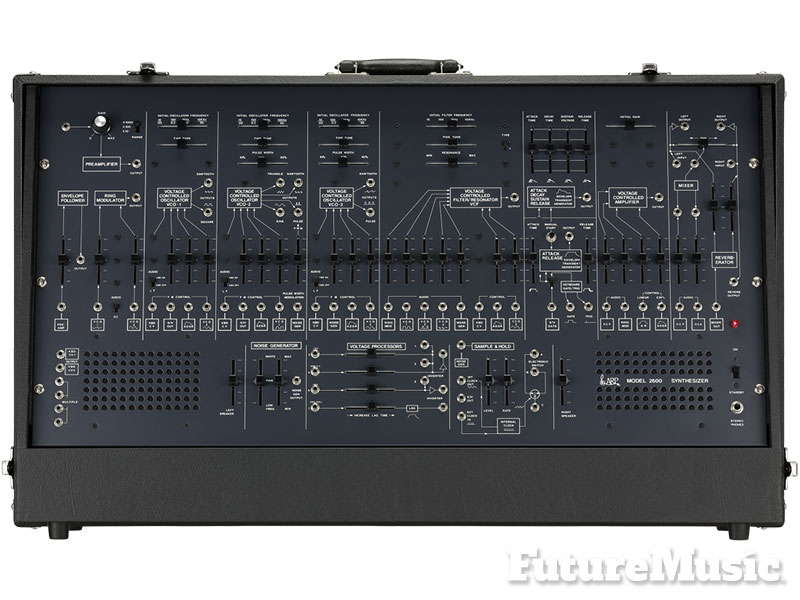While many at the NAMM show were enamored by the ASM HydraSynth, the UDO Super 6 and a couple of other goodies, we found ourselves hanging with Korg. The Japanese manufacturer has been systematically building an arsenal of quality synth gear, honing their offerings and delivering products that are having an impact on every aspect of music production. For electronic musicians in particular, Korg has a wealth of products to meet almost every need. That said, at NAMM their ARP 2600 reissue because official and this should not be overlooked.

While the ARP 2600 will be expensive and only available in limited numbers, it will put this legendary synth in the hands of today’s musicians. Most of the original 2600’s are priced in the five figures arena of the resale market and often find themselves not in working studios, but in synth museums. This means that many younger electronic musicians and synthesizer aficionados have never been able to get their grubby paws on this awesome instrument and see how it transcended popular music. Korg has painstakingly replicated the ARP 2600, right down to its built-in cases, and educational approach to the layout, while adding a few choice modern elements. Behringer, not to be left behind in the current market push for reissues, is also coming out with their own 2600, but with more of a Eurorack approach. While that will certainly appeal to a market segment that will be shut out by the limited numbers of Korg’s offering, and come in at a Behrigner-affordable price point, the team at FutureMusic just couldn’t take our eyes and ears off of Korg’s version.
This one-time-only, limited-edition release is a loving reproduction of the ARP 2600, handcrafted in Japan and includes USB and DIN-style MIDI connections, XLR audio outputs, plus the improved ARP 3620 Duophonic Keyboard with an added arpeggiator / sequencer. The new ARP 2600 will arrive in a custom-branded hard shell case, complete with casters.
The ARP 2600 FS reproduces the sounds of these components at the circuit level. Under the supervision of David FriendAdd a Tooltip Text, the co-founder of ARP Instruments, parts were carefully selected and every detail was adjusted to replicate the original unit’s distinctive synthesis. More than a synthesizer, the ARP 2600 is a complete sound design studio, bridging the gap between the individual elements of modular synthesis and the immediacy of a production / performance instrument. Included are an ample supply of oscillators, envelopes, a filter and amplifier – all of the building blocks of analog synthesis. But the ARP 2600 goes even further, with a spring reverb tank and even a pair of built in monitor speakers. Also present is much of the versatility of a vintage modular system, including a ring modulation, lag and voltage processors, an envelope follower, audio preamp, a clock-able switch, noise source, a sample & hold module, signal inverters, an auxiliary mixer, and even a set of parallel-wired/multi jacks.

Semimodular Design
Nearly every slider and switch on the ARP 2600 front panels is hard wired to specific control source. For example, the front panel controls allow the pitch of Oscillator 1 to be controlled by the keyboard (On/Off switch), the output of the Sample & Hold module (slider), the shape of the ADSR envelope generator (slider), and/or by the sine wave output of Oscillator 2 (slider), and each in varying amounts. These hardwired pathways provide massive amounts of immediate control that make excellent use of all the ARP 2600 has to offer, allowing the ARP 2600 to be played as is – no patching needed. In true modular fashion, inserting a patch cord into the jack associated with any hardwired control overrides that internal connection, letting you create a new signal path of your choosing. As a programming aid, the detailed panel graphics clearly show the available signal routings.

Unlike earlier modular synthesizers that relied on bulky 6.3mm (1/4″) jacks and patch cords, the ARP 2600 uses a more streamlined 3.5mm (1/8″) jack that allows for more patch points to occupy the same amount of panel space, delivering more options and more versatility. Most of the patch points are arranged in a single row below the controls of the individual sound modules. This arrangement keeps the main panel clear and unobstructed for tweaking the controls during performance. Needless to say, these patchable connections and the onboard processors can be used to interact with nearly any modular or Eurorack synthesizer system.

While faithful to the original design, the functionality of the 3620 Keyboard has been greatly enhanced for this limited ARP 2600 release. The 3620 Keyboard contains 49 full-size keys, aftertouch, portamento, and is also duophonic, allowing two keys to be played at once – Single or Multiple Triggering is available. In addition, the duophonic keyboard can use an optional foot switch to lock the interval between any two notes, without retuning the oscillators during performance. Vibrato can be added via a dedicated circuit controlled by aftertouch, or by the onboard LFO (Low Frequency Oscillator), using any of three available waveforms. Most noticeable is the addition of a flexible Arpeggiator that allows a user-defined pattern to be manually sequenced and played back. Still present are the original Pitch Bend knob and the Two Octave Up / Two Octave Down Transpose switch. Connecting the keyboard to the main unit now uses a secure eight-pin din cable.

For a limited time only! Up to 80% off all Waves Bundles. PLUS use Waves promo code “CK901” for an additional 10%! This is Waves best deal yet! Get yours today before this special ends! GO!
The ARP 2600 reveals its modular nature by the unique assortment of valuable, esoteric, and individually patch-able modules it contains. To begin, there are a set of parallel-wired Multiple jacks that enhance the patching possibilities – allowing the same control signal to be sent to multiple locations, for example. Three independent Voltage Processors provide scalable control voltages, or can act to attenuate any control signal. Use the Lag Generator to delay the start of any control signal. The Noise Generator is tunable to deliver White, Pink, and Low-Frequency noise, plus everything in between. A series of three Inverters can reverse the polarity of any signal. The Electronic Switch can be sync’d to either the internal clock or any external clock signal, as can the Sample & Hold rate. Most importantly, the ARP 2600 includes a dedicated Preamp and Envelope Follower for processing an external audio signal.
The Oscillators
ARP Voltage Controlled Oscillators (VCO) are extremely stable in their tuning. All three oscillators feature Initial Tuning and Fine Tuning sliders, and every oscillator can be designated as an LFO (Low Frequency Oscillator) modulating oscillator or as an audio oscillator. (Additional LFO modulation sources are available on the ARP 3620 keyboard; included.) Each oscillator generates multiple wave shapes at once. Available Waves include Sawtooth, Square, Triangle, Sine, and Pulse. The Pulse wave of Oscillator 2 and Oscillator 3 include a manual Pulse Width control, and Pulse Width Modulation is available on Oscillator 2. One audio oscillator can be used to modulate the frequency of another audio oscillator to create analog FM effects.
The Filter
The ARP 2600 is equipped with a 4-pole Voltage Controlled Filter (VCF), offering a roll-off curve of -24dB per Octave. As with the oscillators, the ARP 2600 filter also offers a Fine Tuning slider. The addition of Fine Tuning allows precise and useful control of the pitch of a self-resonating filter. The input mixer stage of the VCF includes sliders for each Oscillator, the Noise Generator, and the output of the Ring Modulator. Over time, the ARP 2600 historically went through a number of changes; some were cosmetic, and some were more crucial to the sound. The Filter Type switch selects between a filter response more closely related to either earlier or later models of the ARP 2600.
The Envelopes & The Amplifier
Two Envelope Transient Generators (EG) are available on the ARP 2600. The first is a full four-stage Attack, Decay, Sustain, and Release Envelope. The second EG offers variable Attack and Release only. The Manual Start button allows the Envelopes to be retriggered at any time, without using the keyboard. The Envelope module also provides both Gate and Trigger outputs – ideal for patching into another analog modular or Eurorack system. In order to produce and output sound, the ARP 2600 relies on a Voltage Controlled Amplifier (VCA) to bring the output up to a suitable level. The Amplifier features both Linear and Exponential control inputs, and the Initial Gain setting provides continuous output at its highest setting. Following the VCA, the audio signal of the ARP 2600 passes through the Stereo Mixer section, the internal Spring Reverb tank, and on to the main outputs, the headphone jack, and the internal Left and Right speakers.

The ARP 2600 is equipped with two low-impedance XLR outputs (Left and Right) for direct connection to a recording console or sound system – no direct boxes or line-matching transformers are required. A headphone output is also provided. MIDI is transmitted and received via old-school din-style IN, OUT, and THRU jacks, and also via USB. Three foot switch jacks (footswitches sold separately) on the 3620 Keyboard provide hands-free performance control over Portamento (On/Off or Momentary) and the Interval Latch. The front panel offers a Preamp input for processing another audio source. Full Korg / ARP 2600 Specifications.
Korg’s ARP 2600 is currently available for pre-order for about US$4000.
Korg
A Brief History Of The ARP 2600








